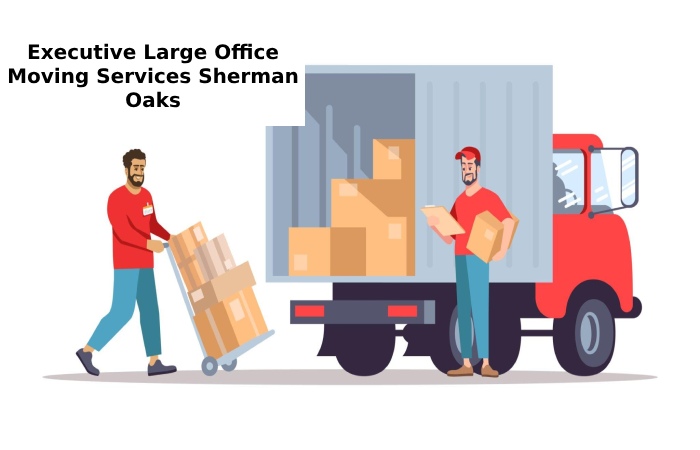Executive Large Office Moving Services Sherman Oaks offers multiple benefits for the customer. Relocating your office can be difficult, mainly if it’s a sizeable executive office that needs to be done with extra caution and accuracy.
Sherman Oaks is a well-liked location for office relocations because of its thriving business community.
However, moving an executive office is a difficult task requiring careful preparation and specialized knowledge.
Executive Large Office Moving Services Sherman Oaks

Relocating a sizable office can be difficult, requiring careful planning, effective execution, and cautious handling of priceless assets. Businesses frequently need expert moving services in Sherman Oaks, California, a thriving commercial center, to guarantee a smooth transfer to a new site. It necessitates thorough preparation, practical implementation, and reducing business interruptions.
For this reason, many Sherman Oaks businesses use extensive executive office moving services. These specialist services provide knowledge and tools to make moving offices easier. We will examine the advantages of using administrative large office moving services in Sherman Oaks in this post, along with some helpful advice to help you plan your office move.
Sherman Oaks Office Moving Service Providers
Address: Bell Gardens, California, 90201, USA; 6850 Suva St.
Serving California and the surrounding areas
Telephone: (800) 264-6313
https://www.sterlingvanlines.com is the website.
- The address is Sherman Oaks, California, 91423, USA, 4730 Woodman Ave UNIT 301.
Serves Montana and the surrounding areas
Telephone: (888) 779-3962
https://www.sdcinternationalshipping.com is the website.
- Address: Sherman Oaks, California, 91411, USA, 14614 Burbank Blvd., Apt. 111
Serviced areas include Orange County and its environs.
Telephone: (800) 298-0044
https://trekmovers.com is the website.
Sherman Oaks is located where?
California, USA, is home to the city of Sherman Oaks. It is a portion of the large metropolis of Los Angeles.
Living in Sherman Oaks is pleasant because there’s much to do and see. Sherman Oaks is a great workplace, which explains why many large office buildings exist. That’s where Sherman Oaks’ Executive Large Office Moving Services is helpful.
These services can remain used by businesses to assist in moving all of their belongings to a new office location. Even though it’s a big task, these professionals are skilled at what they do! Living and working in Sherman Oaks is a terrific choice.
Careful Packaging and Targeted Transport Planning
 Packing and shipping require meticulous attention to detail because significant amounts of delicate equipment and data are involved. To confirm a safe and efficient delivery, our executive large office moving services in Sherman Oaks follow strict protocols, which include:
Packing and shipping require meticulous attention to detail because significant amounts of delicate equipment and data are involved. To confirm a safe and efficient delivery, our executive large office moving services in Sherman Oaks follow strict protocols, which include:
- A unique system of numbered labels to keep track of every item.
- Materials for protective packing of the highest caliber used in the industry
- Climate-controlled cars with GPS tracking
- trucks with cameras and security seals
- Effective route planning using traffic information
Furthermore, we handle specialized items like these with extra caution.
Servers and IT Infrastructure
- Transport cases with shielding stop electrical interference.
- Vibration is absorbed during transit by foam padding.
- Tight climate control keeps out moisture and dust.
Executive Chairs and Wall Decor
- Customized crating options for artwork and antique desks
- Vehicles with air rides reduce shocks
- Moving experts using white glove handling
Protected Records and Storage
- Watertight and fireproof document containers
- Vehicle transportation is done directly without stopgap storage
- a safe chain of custody during transportation
The Skill of Moving Offices

Executive Large Office Moving Services Sherman Oaks!
Moving an executive office is a difficult task. It calls for careful planning, fluid execution, and extensive preparation. One mistake could disrupt operations and cost your business money and effort. At that point, the knowledge of expert professional movers is invaluable when it comes to executive office relocations.
Expert Packaging
- Professional movers safeguard office furniture, electronics, and other belongings during transit using the right packing supplies and tools.
- Furthermore, they might have access to specialized tools or equipment, making moving bulky office supplies like printers or computers easier. They can also work after hours to reduce downtime and productivity interruptions.
- Make sure to check the insurance coverage of the moving company you choose to safeguard yourself against any untoward events during the relocation of your office.
- While some moving companies offer additional policies for high-value items, most only provide basic policy coverage.
- To ensure you receive the best possible service for your office relocation project, you should also find out if they offer any guarantee or warranty on their goods and services.
- Do an inventory of your office assets before you hire Executive large office moving services in Sherman Oaks.
- By doing this, you’ll be able to precisely inventory everything that needs to be moved and won’t miss anything crucial. Set a packing and unpacking schedule to ensure everything gets done on time.
Executive Large Office Moving Services Sherman Oaks: Safe and Secure Transport
Professional moving services for large offices When moving your belongings, Sherman Oaks provides peace of mind. To ensure that every item remains transported as soon as possible and that you can return to work, their staff will carefully pack each item using padded blankets to preserve its condition during transit and safely secure their truck.
Professional moving services for large offices in Sherman Oaks can help plan and provide moving and packing services. Their skilled staff can assist in inventorying the things that need to remain moving, designing a new floor plan, choosing storage locations for office equipment and furniture, and helping arrange insurance coverage for the move.
Executive large office moving services significantly reduce the time and stress of what can otherwise be an intricate and time-consuming task—carrying a large office. Their professionals have all the bases covered for a seamless relocation process that reduces downtime, which is crucial for companies that depend on revenue generation. They specialize in significant office moves. These service providers also offer follow-up to handle any queries or issues arising after the move and post-move support.
Cost-effective Executive Large Office Moving Services Sherman Oaks

- Hiring professional movers when moving to a large executive office is best.
- Using their services, they will be able to evaluate your office space and furniture, make an inventory list of everything under their care, and design a moving strategy that primarily caters to your needs in terms of time and money.
- Professional movers will carefully pack your furniture and equipment into boxes as part of their move service to ensure it is safe for transportation.
- They will unload everything from their truck and set everything up per your instructions once they arrive at your new office.
- Ensure you obtain a free estimate from a moving company before hiring them.
- On the day of the move, this will help avoid any surprises or additional costs.
- Recheck their proposal to make sure all services remain included in that price.
- If you notice any differences between the services rendered and the cost, talk to them about it and, if needed, get clarification.
- Once accepted, arrange the date of your move.
Avoid Common Pitfalls when Selecting an Executive large office Moving Service in Sherman Oaks.
Select the best Executive Large Office Moving Services to relocate your large office to Sherman Oaks. It can be a complex undertaking, and when selecting movers, there are common mistakes that many people make.
We’ll confidently address common mistakes to help you move flawlessly.
Not researching the queries company:
It’s critical to find a reputable moving company to assist with relocating your large office. However, occasionally, people make mistakes and should learn more about the business they select.
It may lead to severe issues in the future!
Services for Executive Large Office Relocation One large company that assists with office moves is Sherman Oaks. However, numerous alternative businesses are similar to it. You should complete your homework before choosing one because of this.
Seek advice from friends or other business owners to ensure that the company you select is reputable. Next, check online reviews left by previous customers of the business.
Choosing only based on cost:
You may believe hiring the least expensive moving company is the best option for relocating your large office. However, the least expensive choice isn’t always the best one! It’s crucial to keep in mind that quality and price aren’t always synonymous.
You may encounter numerous issues if you select an overly inexpensive moving company. To begin with, they require more experience to manage your large office effectively. To move everything safely, they might need the appropriate tools. And last, they may lack the insurance to pay for any mishaps or damages sustained during the move.
Conclusion
That was The Complete Manual for Executive-Scale Office Relocation Services Sherman.
You now know that these services can assist you in relocating your large office. What to anticipate from these services and how to locate the most fantastic offers were also covered.
When relocating to a large office, remember that it’s critical to appoint the right personnel to assist you. Additionally, Sherman’s Executive Large Office Moving Services is a fantastic option!

















 Packing and shipping require meticulous attention to detail because significant amounts of delicate equipment and
Packing and shipping require meticulous attention to detail because significant amounts of delicate equipment and 
